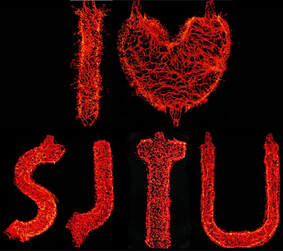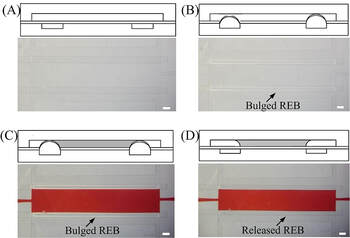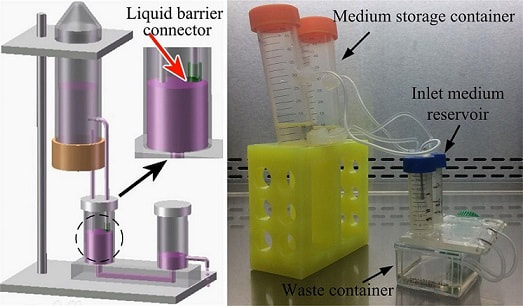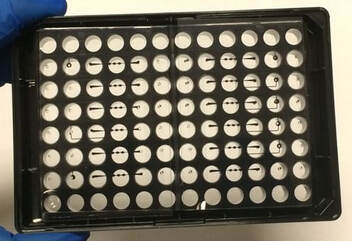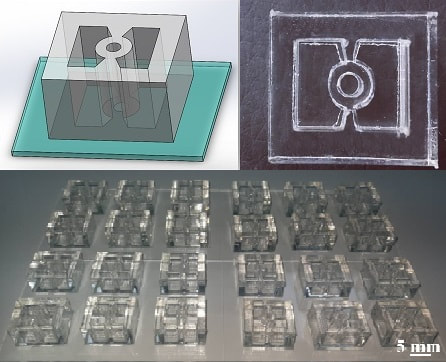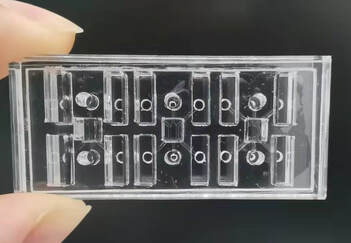Research >> Organ-on-a-chip >> New microfluidic technologies
1. Methods for hydrogel patterningFor most of organ-on-a-chip, the perfusion-based 3D tissue culture models are commonly adopted due to the advantages of nutrient and oxygen supply as well as the waste product removal, which is the necessary condition for long-term microtissue co-culture. Since the geometries of patterned extracellular matrix (ECM) will directly determine the flow profile and thus the cell/tissue stimuli inside hydrogel for a given hydraulic pressure, we designed versatile methods to realize the robust and flexible ECM patterning with high spatial resolution, which would be the key for the construction of dynamic and more physiologically relevant microenvironment on chip.
|
Selected Publications
1. Xiaolin Wang, Duc T. T. Phan, Da Zhao, Steven C. George, Christopher C. W. Hughes*, and Abraham P. Lee*, An on-chip microfluidic pressure regulator that facilitates reproducible loading of cells and hydrogels into microphysiological system platforms, Lab on a Chip, 2016, 16(5), 868-876.
2. Jianghua Pei, Qiyue Sun, Zhiran Yi, Qinyu Li, Xiaolin Wang*, Recoverable elastic barrier for robust hydrogel patterning with uniform flow profile for organ-on-a-chip applications, Journal of Micromechanics and Microengineering, 2020, 30(3), 035005.
3. Ding Wang#, Qinyu Li#, Feifan Wang, Kangyi Lu, Kai Niu, Zhangjie Li, Lian Xuan, Xiaolin Wang*, Dissolvable temporary barrier: a novel paradigm for flexible hydrogel patterning in organ-on-a-chip models, Bio-Design and Manufacturing, 2023, accepted.
1. Xiaolin Wang, Duc T. T. Phan, Da Zhao, Steven C. George, Christopher C. W. Hughes*, and Abraham P. Lee*, An on-chip microfluidic pressure regulator that facilitates reproducible loading of cells and hydrogels into microphysiological system platforms, Lab on a Chip, 2016, 16(5), 868-876.
2. Jianghua Pei, Qiyue Sun, Zhiran Yi, Qinyu Li, Xiaolin Wang*, Recoverable elastic barrier for robust hydrogel patterning with uniform flow profile for organ-on-a-chip applications, Journal of Micromechanics and Microengineering, 2020, 30(3), 035005.
3. Ding Wang#, Qinyu Li#, Feifan Wang, Kangyi Lu, Kai Niu, Zhangjie Li, Lian Xuan, Xiaolin Wang*, Dissolvable temporary barrier: a novel paradigm for flexible hydrogel patterning in organ-on-a-chip models, Bio-Design and Manufacturing, 2023, accepted.
2. Microfluidic microcomponentDelivery of continuous and steady medium flow with accurate flow control is essential for 3D cell/tissue culture inside microfluidic devices. The hydrostatic pressure-driven passive micropumps are simple and widely used, but they cannot maintain steady and continuous flow for long periods of time. Here, we proposed a hydrostatic pressure-driven passive micropump enhanced with siphon-based autofill function, which can realize the autonomous and continuous perfusion with well-controlled steady flow over an extended time without electric power consumption.
|
Selected Publications
1. Xiaolin Wang#, Da Zhao#, Duc T.T. Phan, Jingquan Liu, Xiang Chen, Bin Yang, Christopher C.W. Hughes, Weijia Zhang * and Abraham P. Lee *, A hydrostatic pressure-driven passive micropump enhanced with siphon-based autofill function, Lab on a Chip, 2018, 18(15), 2167-2177.
1. Xiaolin Wang#, Da Zhao#, Duc T.T. Phan, Jingquan Liu, Xiang Chen, Bin Yang, Christopher C.W. Hughes, Weijia Zhang * and Abraham P. Lee *, A hydrostatic pressure-driven passive micropump enhanced with siphon-based autofill function, Lab on a Chip, 2018, 18(15), 2167-2177.
3. Chip microfabricationThe traditional PDMS-based microfluidic devices suffer from the microfabrication with complex processes and usage limitations of either material properties or microstructure design, which drive the demand for easy processing and more accessible devices with a user-friendly interface. Here, we developed both closed and open microfluidic devices with versatile microfabrication methods, like hot embossing, laser cutting, etc. In addition, especially for drug screening applicaitons, it is necessary to develop the platform with multiple units in a standard well plate format, which could be compatible with robotic liquid handlers and automatic fluorescent plate readers.
|
Selected Publications
1. Duc T. T. Phan#, Xiaolin Wang#, Brianna M Craver, Agua Sobrino, Da Zhao, Jerry C Chen, Lilian Y.N. Lee, Steven C George, Abraham Lee* and Christopher Hughes*, A vascularized and perfused organ-on-a-chip platform for large-scale drug screening applications, Lab on a Chip, 2017, 17(3), 511-520.
2. Qinyu Li, Kai Niu, Ding Wang, Lian Xuan and Xiaolin Wang*, Low-cost rapid prototyping and assembly of open microfluidic device for 3D vascularized organ-on-a-chip, Lab on a Chip, 2022, 22(14), 2682-2694.
1. Duc T. T. Phan#, Xiaolin Wang#, Brianna M Craver, Agua Sobrino, Da Zhao, Jerry C Chen, Lilian Y.N. Lee, Steven C George, Abraham Lee* and Christopher Hughes*, A vascularized and perfused organ-on-a-chip platform for large-scale drug screening applications, Lab on a Chip, 2017, 17(3), 511-520.
2. Qinyu Li, Kai Niu, Ding Wang, Lian Xuan and Xiaolin Wang*, Low-cost rapid prototyping and assembly of open microfluidic device for 3D vascularized organ-on-a-chip, Lab on a Chip, 2022, 22(14), 2682-2694.


